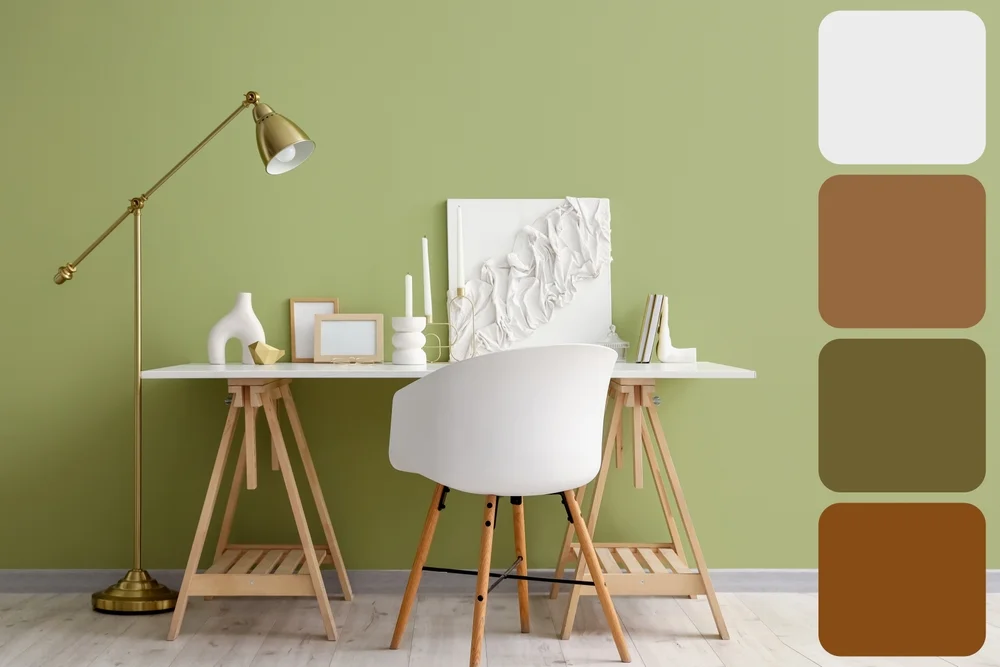
Primary Colors for Office Spaces
Blue: The Color of Productivity
Blue is often associated with tranquility and intelligence. It's an excellent choice for spaces where focus and mental clarity are paramount, like individual workstations or quiet zones.
Green: The Color of Balance
Green symbolizes nature and is known for its calming effects. It's perfect for areas where you want to promote relaxation and reduce stress, such as break rooms or collaborative spaces.
Yellow: The Color of Optimism
Yellow is a bright, cheerful color that can inspire creativity and positivity. It’s ideal for creative departments or areas where brainstorming and innovative thinking are encouraged.
Secondary Colors and Their Effects
Orange: The Color of Enthusiasm
Orange is a warm and inviting color that can boost energy and enthusiasm. Use it in spaces where you want to encourage interaction and lively discussions, like meeting rooms or common areas.
Purple: The Color of Creativity
Purple is often linked to creativity and luxury. It can be a great choice for design studios or any area where creative work is done, adding a touch of sophistication and inspiration.
Red: The Color of Energy
Red is a powerful color that can stimulate and energize. It's best used sparingly, in areas where you want to make a bold statement or evoke a sense of urgency, like a sales floor or a brainstorming corner.
Recognizing and appreciating employees' efforts and achievements boosts morale and motivates them to maintain high performance. Regular recognition can take various forms, including verbal praise, awards, and incentives.
Neutral Colors and Their Roles
White: The Color of Cleanliness
Promoting a healthy work-life balance helps prevent burnout and ensures employees are engaged and productive. Organizations can support work-life balance through flexible work arrangements, wellness programs, and encouraging time off.
Gray: The Color of Professionalism
Gray is a neutral color that exudes professionalism and sophistication. It’s perfect for corporate environments and can be paired with bolder colors to create a balanced look.
Black: The Color of Sophistication
Black adds a touch of elegance and authority. Use it as an accent color to create contrast and depth without overwhelming the space.
Combining Colors for Different Areas
Reception Area
The reception area is the first impression visitors have of your office. Use welcoming and warm colors like orange and yellow, paired with neutral tones to create an inviting atmosphere. .
,Workstations
For workstations, opt for colors that enhance focus and productivity, such as blue and green. Balance these with neutral shades to avoid overstimulation.
Meeting Rooms
Meeting rooms should encourage both focus and creativity. Consider a mix of blue for concentration and orange for energy, ensuring a balanced and dynamic space.
Break Rooms
Break rooms are for relaxation and rejuvenation. Green is ideal for its calming effects, combined with a splash of yellow to maintain a positive and uplifting environment.
Lighting and Color Interplay
Natural Light vs. Artificial Light
Natural light enhances the true colors and can make spaces feel more open and inviting. Artificial light can alter the appearance of colors, so it’s important to test your color choices under the lighting conditions present in your office.
How Lighting Affects Color Perception
Different lighting conditions can make the same color look completely different. Always consider the type and amount of light in each area when choosing colors to ensure they look as intended.
Incorporating Brand Colors
Reflecting Brand Identity
Incorporate your brand colors subtly throughout the office to reinforce your company’s identity. This can be done through furniture, décor, or accent walls.
Use brand colors in a way that complements the overall color scheme. They can be used dominantly in reception areas and subtly in workspaces to avoid overwhelming the employees.
Trends in Office Color Combinations
Current Trends in Office Design
Current trends favor biophilic design, incorporating natural colors and materials to create a calming and productive environment. Earthy tones and greens are particularly popular.
Predictions for Future Trends
Future trends might lean towards more personalized and flexible color schemes, allowing for dynamic and adaptive workspaces that can change according to the needs of the moment.
Tips for a DIY Color Makeover
- 1. Assess your current color scheme and identify areas for improvement.
- 2. Choose a primary color and two to three complementary colors.
- 3. Paint a small section of the wall to test your choices under different lighting conditions.
- 4. Once satisfied, proceed with painting the rest of the space.
- 5. Add accent pieces and décor to complete the look.
Common Mistakes to Avoid
- Overloading the space with too many bold colors.
- Ignoring the impact of lighting on color perception.
- Neglecting the importance of balance between bold and neutral tones.
- DIY projects can be more affordable, but they require time and effort. Weigh the cost of materials and your time against the benefits of professional results.
Ultimate Guide Coordinating office color combinations is more than just a design choice; it's a strategic decision that can impact productivity, creativity, and overall well-being. By understanding color psychology and considering the specific needs of different areas, you can create a vibrant and cohesive office environment that supports your team's success. Safe Hand Interior is the best for choosing the Ultimate Guide to Coordinating Office Color Combinations in Ahmedabad, Gujarat.
Frequently Asked Questions
Consider the primary function of the space and the mood you want to create. Use color psychology to guide your choices, and test colors under the actual lighting conditions of your office.
Yes, colors can significantly affect mood and behavior. For example, blue can enhance focus, while green can reduce stress, both of which can improve productivity.
Colors like yellow and purple are great for creative workspaces as they inspire optimism and creativity. Incorporating these with neutral tones can create a balanced and stimulating environment.
There's no set rule, but a good practice is to review your office color scheme every few years to ensure it still meets your needs and aligns with current trends.
Investing in professional design services can be worthwhile if you want a cohesive, polished look and expert advice. Professionals can help you avoid common mistakes and ensure the end result supports your goals.
 style="translate: none; rotate: none; scale: none; opacity: 1; transform: translate(0px, 0%);">
style="translate: none; rotate: none; scale: none; opacity: 1; transform: translate(0px, 0%);">